Some bugs with lots of legs can look scary. Multiple species may even look venomous as they might not be as common as other types of bugs with fewer legs.
Bugs may have hundreds of pairs of legs. Furthermore, they may even grow extra legs as they mature.
Other species might have fake legs or pedipalps, sensory organs often confused with legs and counted as true legs.
Here are some of the most common species with many legs that may be encountered in North America.
Table of Contents
1. Millipedes
There are more than 1.000 species of millipedes in the world, most having at least a few hundred legs.

The name of the species is derived from Latin, and it means thousand. While millipedes don’t have one thousand legs, they can have anywhere between 300 and 700 legs.
In the US, Illacme plenipes millipedes have the most legs. They have an average of 650-700 legs and can be found in states such as California.
The thin legs of the species also vary by gender. Males tend to have a few hundred legs less than females.
2. Centipedes

Centipedes are another very common moisture-loving species with a high presence in North America.
This species doesn’t have as many legs as millipedes, but it comes close with a number of up to 383 legs.
Unlike millipedes, centipedes only have one pair of legs per body segment.
Almost 10.000 species of centipedes exist around the world. They have a brown or a red-brown color in their vast majority.
You can find these types of bugs with lots of legs in gardens, under mulch, under leaf litter around the house or in woodlands, in rotting wood, or in any other high-humidity location.
3. Isopods

Isopods are among the common aquatic or terrestrial crustaceans with many legs.
This species has 7 pairs of legs and 5 pairs of appendices often confused with legs.
Isopods live in the water, typically on the seabed or on the bottoms of lakes. They can also be terrestrial, with a high preference for high-moisture habitats.
There are more than 10.000 species of isopods around the world. Most of these species live near the bottom of seas, rivers, and lakes.
While they live in the water, they move using their legs.
4. Silverfish

Silverfish are some of the most common bugs with many legs in homes. These bugs are often found in bathrooms, basements, and other high-moisture areas around the house.
Silverfish have 6 legs, 2 long antennae, and a pair of appendices at the rear end.
These bugs move by crawling and they rely on their multiple legs for quick movements. Unlike other bugs with plenty of legs, silverfish can also jump a few times their height.
Silverfish are known for their diverse diet that includes less common foods such as cardboard and paper.
5. Spiders

Most spiders have 4 pairs of legs or 8 legs. These legs can be short, long, thin, or robust.
Some spiders can rely on their legs for crawling while other spiders such as jumping spiders have spring-like legs that help them jump around.
Regardless of the species, spider legs have 7 segments and tend to work on pneumatic-like principles instead of relying on muscles.
The legs of species such as The Brown Recluse may also appear prominent, a few times longer than the body.
Some spiders also have vibration receptors in their legs which help them recognize the moment insects get caught up in the spider web.
6. American Carrion Beetle Larvae
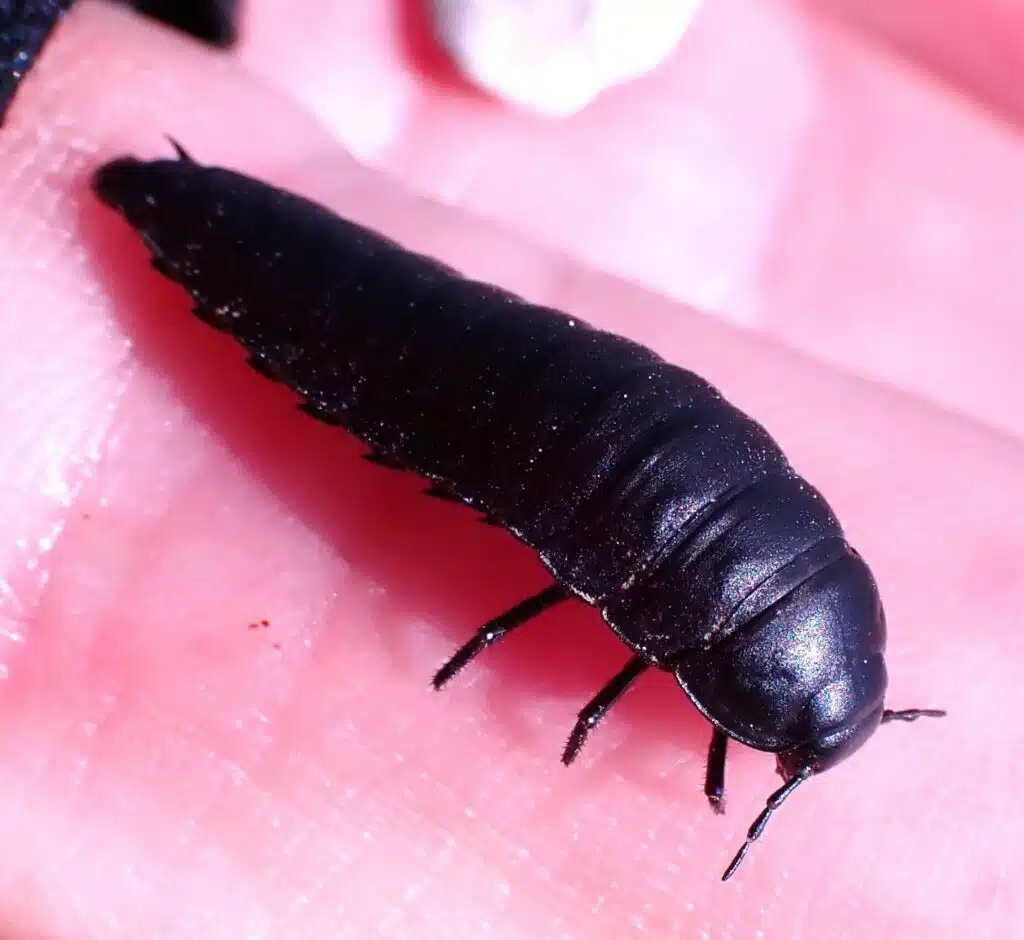
American Carrion Beetle Larvae (Necrophila americana) look similar to silverfish with their elongated body that narrows at the rear end.
This species has 3 pairs of legs and multiple antennae which makes it appear as if having more legs.
Crawling movements are specific to this larva which grows in carrion and other types of decaying meat around the house.
This species maintains its number of legs into adulthood as well as its visible antennae but it changes coloring from black and its elongated shape to a rounder shape.
7. Mealybug Destroyer Larvae

The larvae of mealybug (Cryptolaemus montrouzieri) destroyers are known to grow up to a size of 12mm.
These tiny larvae have multiple barely-visible legs. A smaller body and a high number of legs allow the larvae to move fast.
Mealybug Destroyer Larvae even move faster than adults.
This species has a pink color and a slightly flattened body shape that resembles the shape of fruit seeds.
It takes about 5 days for the newly-laid eggs of the species to turn into larvae.
8. Small Tortoise Beetle Larvae
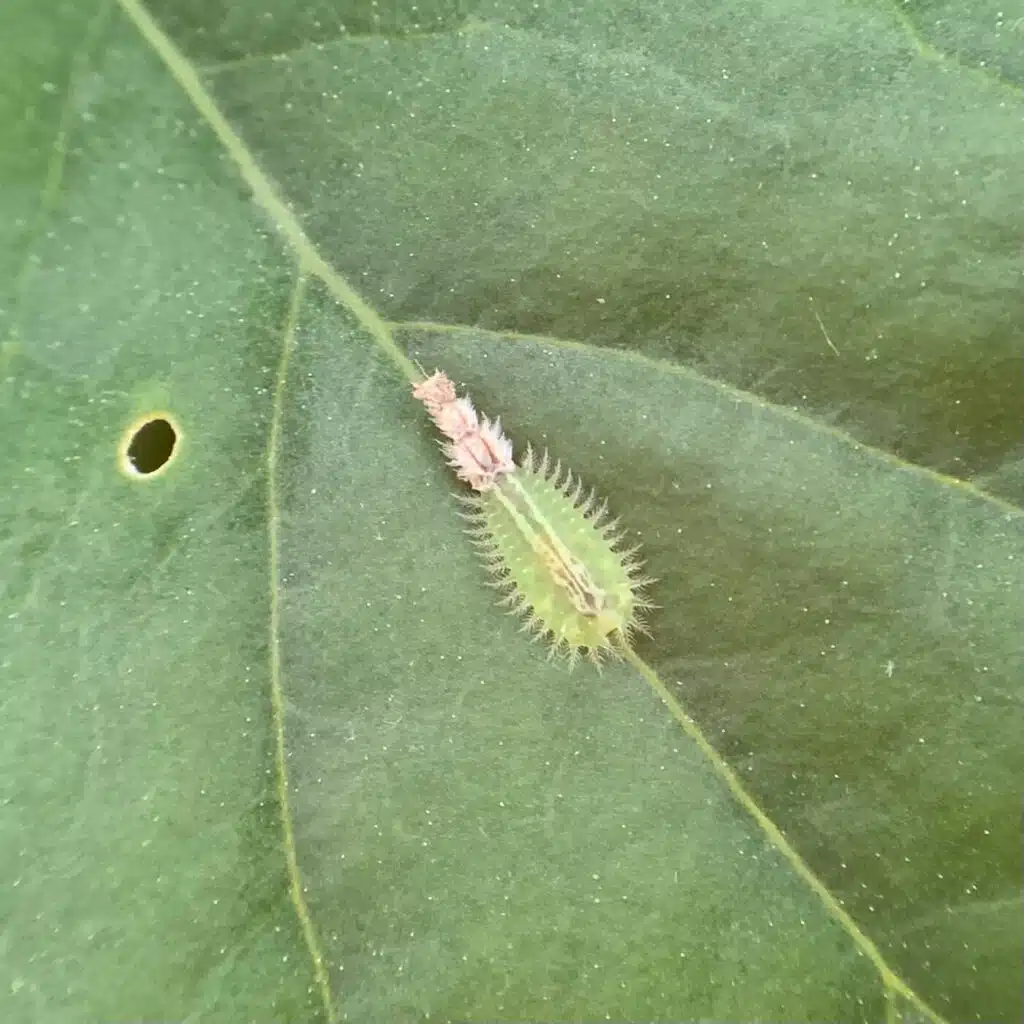
An introduced species in The United States, Small Tortoise Beetles (Cassida piperata) may also be referred to as Leaf Beetles.
The larvae of the species have a stand-out appearance with a green upper body and a tan-brown rear body section.
Tens of small legs are seen around the upper green area of its body. This is a species that only has as many legs as larvae as adults have fewer legs.
While it has many legs, the Small Tortoise Beetle Larvae only move at a slow speed.
9. Wild Olive Tortoise Beetle Larvae
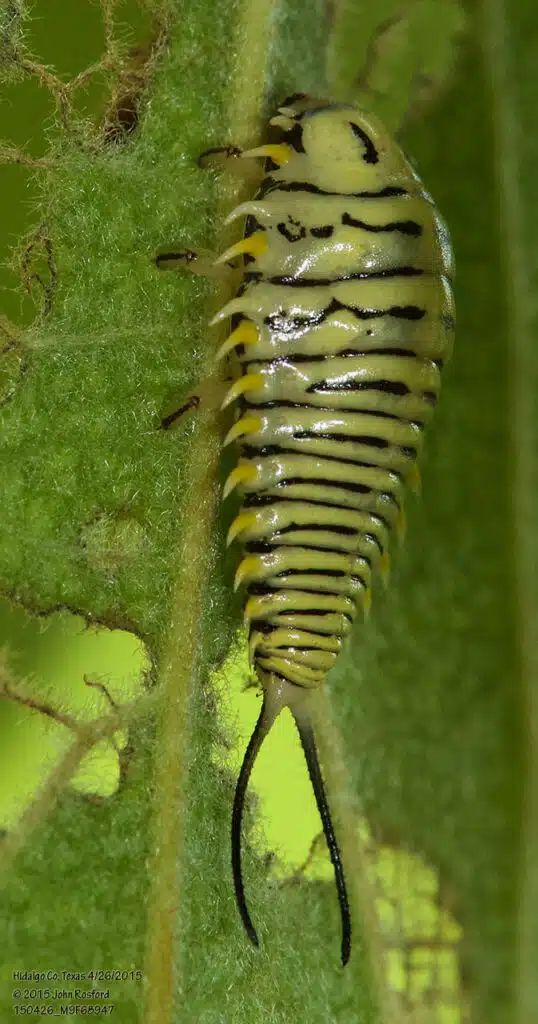
One of the larvae with many legs that aren’t well-known due to their rare profile is the Wild Olive Tortoise Beetle Larvae (Physonota alutacea).
This small yellow species have multiple legs and long rear-end antennae-like projections which may also be confused with legs.
In the US, this species may only be seen in the extreme South of Texas where the species is seen feeding on Mexican Olive.
Small clusters of Wild Olive Tortoise Beetle Larvae are spotted on the leaves of the species due to their eusocial status.
10. Lacewing Larvae

Lacewing Larvae have a common shape in the world of bugs, often being confused with caterpillars or beetles.
The lower part of the body tapers towards the rear end, similar to the shape of certain caterpillars.
This is a species with 6 legs which are quite strong. As a result, Lacewing Larvae move quickly, often running faster than other types of bugs such as ladybeetles.
Larvae of this species also have very long legs which may make them look similar to spiders with very long legs.
11. Fishfly Larvae

This species of larvae have varying sizing. It measures anywhere between 1 and 4 inches and it’s a species often confused with centipedes.
A tan, brown, and black body are specific to this type of larvae.
6 to 7 pairs of appendices are seen along its body. These appendices look very similar to legs, making these larvae a species often confused with a fast crawler based on its many pairs of legs.
The larvae are omnivorous, mainly feeding on small insects, other larvae, and bug eggs.
12. Dobsonfly Larvae

This type of larvae lives in both terrestrial and aquatic habitats.
It has a multi-segment body with most of these segments showing a pair of appendices.
While they look like true legs, these appendices are used for defensive purposes. It keeps different predators such as larger bugs away.
Dobsonfly Larvae further have 3 pairs of prolegs closer to the head.
Orange and brown colors are specific to these types of larvae.
13. Caterpillars

Caterpillars are some of the species best-known for having multiple prolegs.
Multiple butterfly and moth caterpillars are known for having visible prolegs.
Monarch caterpillars, for example, have 5 pairs of prolegs. These help the species move around its favorite leaves which serve as a host.
The species also has black tentacles at the head and at the rear. Often confused with antennae, these tentacles help caterpillars identify their hosts by texture as well as sense temperature changes.
True legs and prolegs are distinguished on most types of caterpillars.
Each species shows a different number of prolegs. This number may further be impacted by the instar or growth stage of each caterpillar.
Caterpillars of butterflies such as Monarch and Black Swallowtail Caterpillars are known for having a considerable number of prolegs.
14. Pseudocentipedes
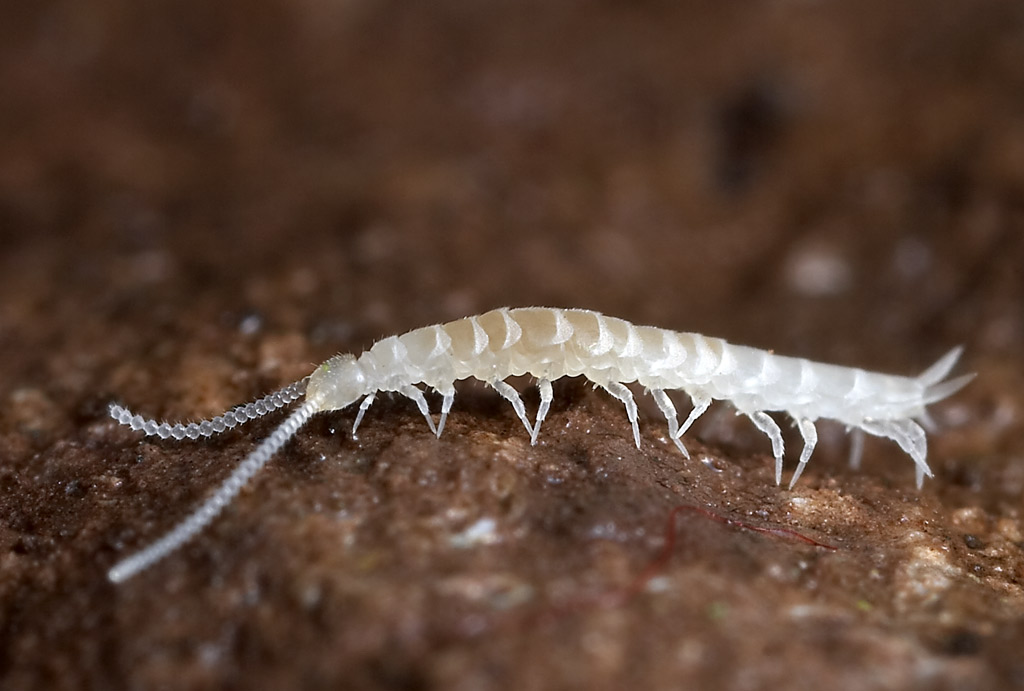
This type of arthropod (Class Symphyla) is highly similar to centipedes although it has no direct relationship with the species.
Pseudocentipedes also live in the ground. They can be found in moist soil, typically just under the surface.
Some Pseudocentipedes can dig deeper, but rarely more than a few inches in the ground.
This is a species born with 6 pairs of legs. Each molt or each growth stage comes with an extra pair of legs for the species.
Arthropods of the family grow to a maximum of 12 pairs of legs, doubling in number as they mature.
This species has a white-to-translucent appearance as it lives underground.
It rarely comes up to the surface as it prefers to feed on decaying vegetation just below the surface.
15. Harvestmen
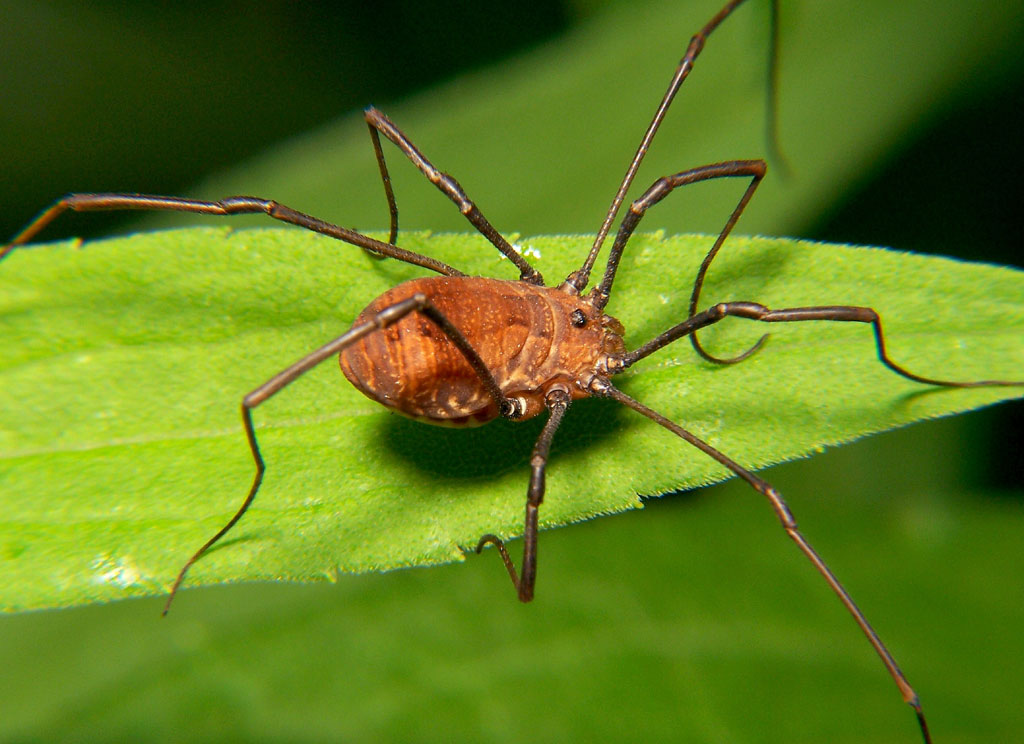
Harvestmen are often confused with spiders due to also having 4 pairs of legs.
However, Harvestmen have 2 pedipalps which look like antennae or short legs in the front in addition to their legs.
Often called Daddy Long Legs, Harvestmen may also be confused with Daddy Long-Legged Spiders.
Unlike these or other spiders, Harvestmen have round bodies and they don’t bite.
Releasing a bad smell is one of the few defensive methods Harvestmen have in front of predators such as robins.
16. Scorpions

Scorpions are a native species in some Southern territories of North America.
They have 8 legs and are known for their fast movements across various grounds. Long front pincers limit the speed of scorpions as these are considerably larger than their legs.
Scorpions are some of the most dangerous types of bugs with long legs. While rare, their bites often require hospitalization.
Scorpions may use their front pincers to hold on to prey before using their venom bulb or after using their venom bulb.
Small prey such as insects or bugs is sliced by these powerful front pincers for the scorpions to easily eat.
17. Pseudoscorpions

Smaller but similar to scorpions, pseudoscorpions have at least 5 distinguishable body segments.
Each of these segments grows at least a pair of legs.
Pseudoscorpions have 8 legs each. 2 long pedipalps in front are either confused with pincers or with legs.
This type of arachnid feeds on some of the smallest bugs in the ecosystem such as mites and carpet beetle larvae.
People typically kill these arachnids wrongly identifying them as true and venomous scorpions.
These arachnids may settle indoors, with sufficient access to food such as insects or mites.
They multiply once or twice per year with a single female laying up to 40 eggs at least once per year.
18. Camel Spiders

Some of the largest bugs with lots of legs are Camel Spiders. These solifuges are often confused with real spiders.
They have 5 pairs of legs with the first pair being pedipalps.
Solifes of this genus has long legs and large body. They easily grow to a size of more than 5 inches meaning they are some of the largest bugs that feed on spiders and other insects.
Camel Spiders rely on their long strong legs to quickly pounce on prey. They show opportunistic feeding habits meaning no days are the same in terms of eating.
This species only uses the rear 3 pairs of legs for running but it relies on its large eyes and excellent vision to trap prey in its sight.
19. Vinegaroons

These types of arachnids are part of the same genus as spiders but they resemble scorpions.
Most believe Vinegaroons have 10 legs. However, these arachnids only have 6 pairs of legs as the 4 front pedipalps are sensory organs.
These rely on these pedipalps to sense temperature changes or humidity.
Black color is specific to vinegaroons, a further reason why some may confuse the species with scorpions.
Vinegaroons are nocturnal and rarely spotted looking for prey. They only come out at night looking for bugs and insects.
These arachnids have very strong front legs. Female Vinegaroons use their front legs to dig burrows when laying eggs.